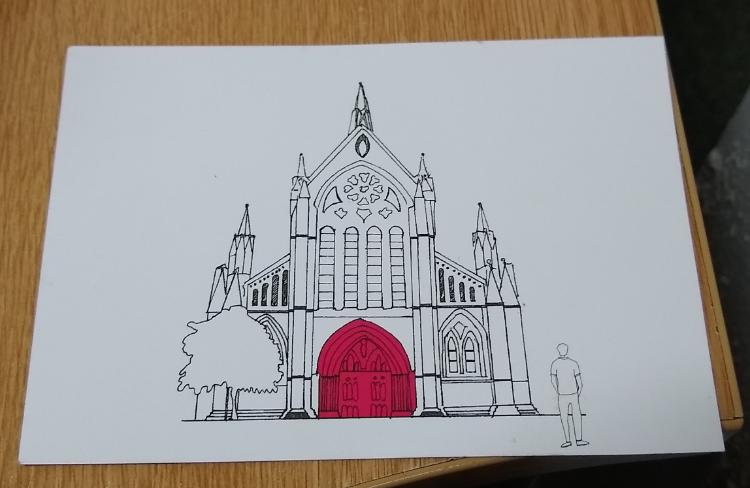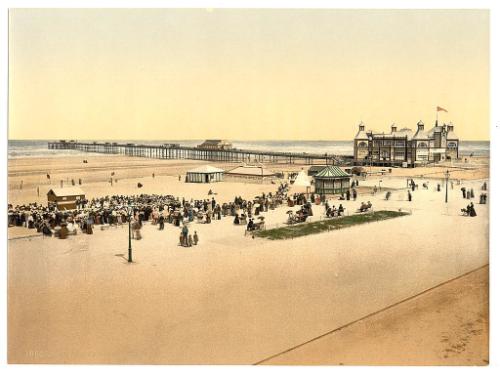Im/material Event #4: Design Practice, Immersive Experiences, and Making Future Places

Virtusphere (Photo credit: Mihaelawojcik [CC BY (https://creativecommons.org/licenses/by/4.0)])
|
|
The fourth and final im/material network panel discussion, Design Practice, Immersive Experiences, and Making Future Places, was hosted by the University of Edinburgh on 5 November 2019, jointly supported between the im/material network and Creative Informatics. This event focused on addressing whether VR, AR, and other immersive technologies are affecting design practices in architecture and planning.
Our panel members first each gave ‘lightning talks’ to provide background on their perspective on these immersive technologies and the approaches they employ in their work. This was followed by a discussion between the panel members based on themes that arose during the presentations. Finally, attendees were able to try out VR demos of Loqui and Jupiter Artland in Minecraft.

VR in the Sharing Economy
The first lightning talk was given by Prof Richard Coyne of the University of Edinburgh, in which he discussed Virtual Reality and the Sharing Economy. The concept of a sharing economy underlies things like AirBNB before it became commercialised, or the use of cryptocurrency – goods and services are exchanged either for free or for a fee between private individuals through an anonymous platform. Decentraland operates under a similar concept, where individuals buy digital ‘land’ where they will eventually be able to share or sell digital content, whether 3D assets or entire interactive systems or games. Richard highlighted that this has implications for VR, AR and immersive environments, where peer-to-peer transactions, selling these 3D assets, can take place in these virtual environments. For people working in the built environment, he stated that this is particularly interesting when considering that these 3D assets correspond to physical things that can be added to a building site and how the 3D model and the physical assets interact with each other, the immaterial with the material. He asked if things like Decentraland are disruptive, if it’s a fad, or whether it causes us to think differently about how we manage and design the world around us?

The first drawing of the Eiffel tower, an example of the triumphs of modelling
The second lightning talk was given by Dr Rachel Cruise of the University of Loughborough. She discussed how the physical process of making the built environment involves several stages, including the extraction of raw materials, refining those materials to ensure consistency and reliability, and finally forming and shaping the product to meet standards set at the outset. The less physical aspect of this process is modelling, which can be equations or a computer model, which allow predictions to be made about how a certain design will impact the final product. While the models can be convincing, they are a subjective and political process, especially when the modeller decides which factors to take into account. This interaction between modelling and production often trends towards standardisation, but this can cause problems in the actual construction of a space or building. Building sites introduce variability, and Rachel argued that designing with variable elements, like free-form inflated beams, are less predictable, but are better for the environment and embrace the variability each new build site introduces.

A SENSEcity compatible postcard Pooja provided at the event
Pooja Katara, owner of SENSEcity, gave the third lightning talk about her immersive storytelling app. This augmented reality app is paired with a physical booklet showcasing hand-drawn illustrations to tell stories about the public spaces and public life in Glasgow in an engaging way. This narrative tool uses a digital layer of creative space to complete the stories told by the illustrations; this includes an audio guide with stories told by engaging characters, old photographs, and animated 3D models.

Rhyl Sands in the 1890s, Credit: The Library of Congress.
Jimmy Loizeau gave the final lightning talk, in which he discussed his work with the ‘Illegal Town Plan’. The project was prompted by the planned redesign of Jimmy’s home town of Rhyl, Wales in 2013. Rhyl had been a seaside resort town and was a popular tourist destination until the 1970s; subsequent developments in city planning had focused on building retail parks, which often involved the demolition of key architecture from its heyday. Jimmy took to social media and asked what the community would want to see in a fictional town plan. He took those suggestions and used photoshop to ‘bring back’ key features like the old fairgrounds, combined the aesthetics of the fairgrounds with the offshore windfarm, added a racetrack to the beach, and redesigned the pier by combining it with the Royal Floral Hall, which had been demolished in the 1990s. While this process was an ‘artificial reality’, the Illegal Town Plan made it clear that people missed these old bits of their community. The plan came to represent the voices and opinions of local community groups that were affected by town planning but were seldom offered an opportunity to comment on the organisation and direction of their communities. In addition to the digital aspects, the project also brings students to engage with the community in different ways, and even put the word ‘Rhyl’ back in the Rhyl Rock candy. This was a minimal but meaningful reversal that, together with the other components of the project, has brought attention to the ideas behind the project, and development professionals now want to consult with them.
Nostalgia and the Past

The Rhyl Pier in the 1890s, Credit: The Library of Congress.
Richard was the moderator for this event, and he pinpointed several interconnecting themes that recurred in the lightning talks for further discussion. The first of these was ‘nostalgia and the past’ – he first asked the panel whether virtual environments are a way to get us to the past. Jimmy argued that nostalgia can be used as building blocks to get people involved, but that we need to be realistic about the future. Rhyl isn’t going to be a seaside resort town again, but we need to ask how the past can inform future development. Pooja said that in developing SENSEcity, 90% of users wanted the historian to stay on as a character in the app, which she thought reflected the strong focus on heritage in the tourism industry. She also argued that Augmented Reality (AR) and Virtual Reality (VR) in particular allow for authentic stories of the past to be overlaid on the physical space of the present. Finally, Rachel pointed out that it was difficult to create a world without referencing what we’re familiar with – architectural software known as CAD has taken a lot of the physical actions of drawing, painting, and making and imbued them into the virtual world. This is all symptomatic of how difficult it is to imagine a world different than the one we’re in.
Imagination
Richard pointed out that metaphor and imagination joined each of the talks today. Jimmy observed how difficult it was in the ‘Illegal Town Plan’ to get people to dream things up, and that nostalgia was a way to transition towards a future vision for the town. Pooja agreed that SENSEcity started as a crazy idea in imagination, but then these concepts move towards reality and become less so.
Transgression
The third theme identified by Richard was transgression – being based in Edinburgh he joked that Pooja’s book must be filled with transgressions because it is about Glasgow. Pooja reflected and said that her transgression was working in Glasgow despite being encouraged to work in Edinburgh, but Glasgow has its own industrial past that she finds quite beautiful. Richard then asked Rachel if architects using relatively constrained software can be transgressive. She argued that the notion of a predictive model is part of the imagination, as what is incorporated into the model is subjective and based on personal objectives and priorities. Through the model, one can get to ridiculous and sublime places.
The Physical thing, the Virtual thing, and Design
An inflatable steel beam, a move away from standardised building materials (Photo credit: Rachel Cruise)
Finally, Richard pointed out that in all of these discussions, the relationship between the physical thing, the virtual thing, and how it affects the material design was quite interesting. Pooja stated that SENSEcity started as storytelling through ink illustrations, and that the AR element came in much later after she realised how adding another layer could complete the drawings with sounds and spaces from the past. She had considered making it an app-only experience, but it currently works regardless of GPS location. In the case of the ‘Illegal Town Plan’, Jimmy reflected that the physical elements of the project, namely the ‘Rhyl Rock’ and an album that is currently in production, operated in the world as many things – as a conversation starter, a business card – and communities have formed around the material object. Rachel agreed that the gathering of different people or professions having discussions around the same object is key to move in new directions. Virtual Reality could help with the intersection between imagination and physical – while things like gravity and strength don’t translate into VR yet, you can look at the geometry of the same thing as a common point of reference, though you may interpret it in a different way. She argued that this may help in construction where different professions intuitively learn different ways of working, or it could help digital fabrication move away from standardised materials and towards more adventurous material production processes. Pooja observed that the knowledge gap between the experts and the users would need to be bridged before Rachel’s vision of a designer modifying immersive technologies to suit the individual’s process can be achieved.
Richard Coyne - Three-dimensional digital assets correspond to physical things added to a building site - if we consider how the 3D model and the physical assets interact with each other, is this disruptive? Or is this a fad? Are we thinking differently about the world around us, how we manage it, and how we design it?
Rachel Cruise - This event brought together the theoretical, very poetic and practical but currently tangible applications, as well as the highly imaginary potential of virtual and augmented worlds. All presentations were observed by Prof. Richard Coyne to project a certain nostalgia which contrasted against the potential for such technology to open up new worlds. This exciting potential of such new technology is seemingly an elusive goal as our imagination struggles not to reference an understanding or reading of our physical world in this new territory.
Jimmy Loizeau - The brilliant bit about Neil...was that he was not only modelling a pier, but he was suggesting a whole new economic model for the town, which the politicians had forgotten to do...everyone's trespassing now in really...interesting ways, and all we've [the Illegal Town Plan] done is act as a little glitch to stop them from doing another retail park.
Pooja Katara - There was a prediction that, especially in the travel industry...about 84% of the travellers in 2025 will be expecting an immersive experience...the way I see it is that, there needs to be more communication between...the experts and the users.
Im/material Event #4 Recording: Design Practices, Immersive Experiences, and Making Future Places
Projects Encountered during the Event
Loqui - Learning Language in VR
Jupiter Artland in Minecraft - by Tom Flint
Decentraland and the Sharing economy
SENSEcity - Pooja Katara's AR App
The Illegal Town Plan: Rhyl - Jimmy Loizeau's work with Rhyl



